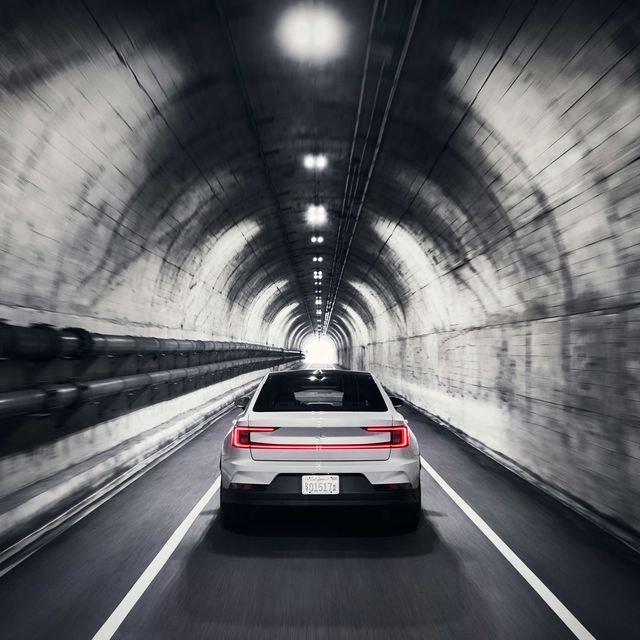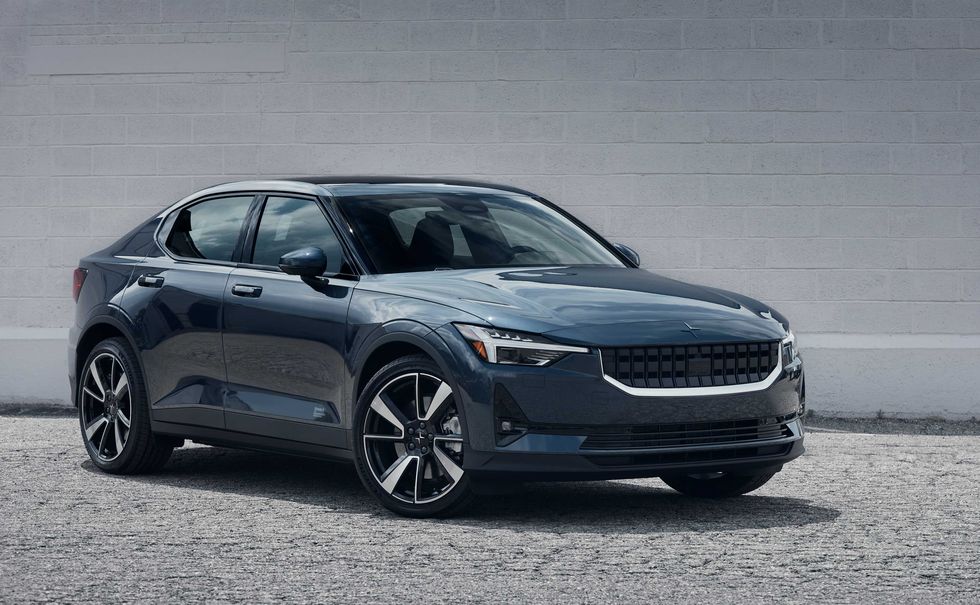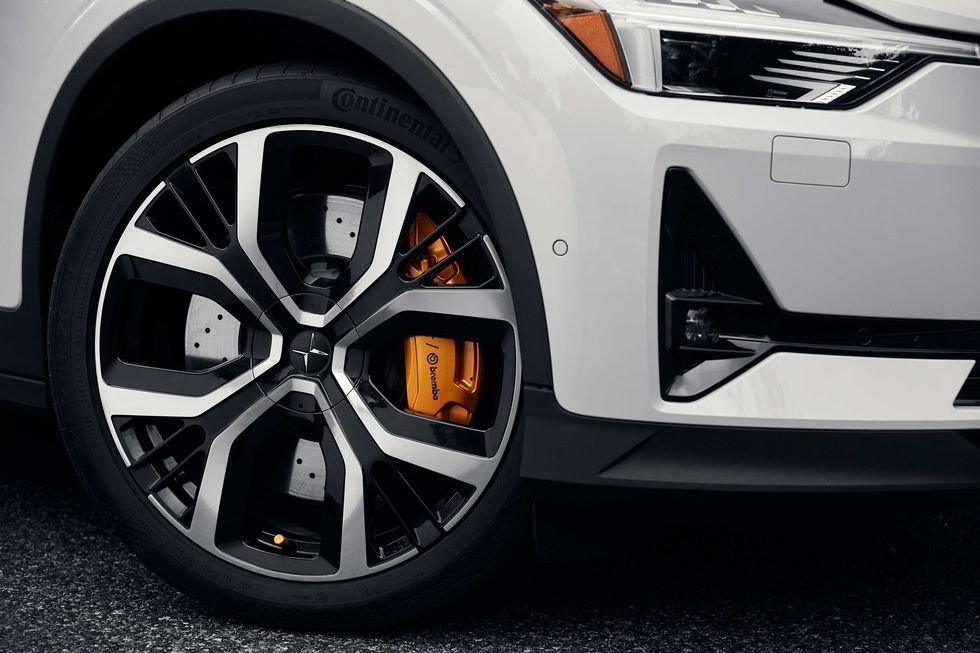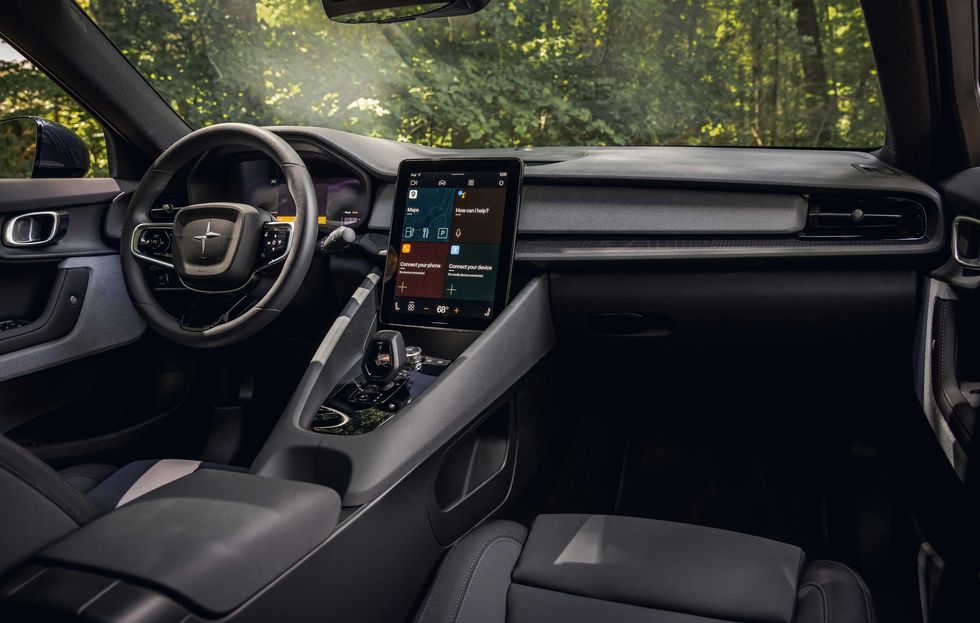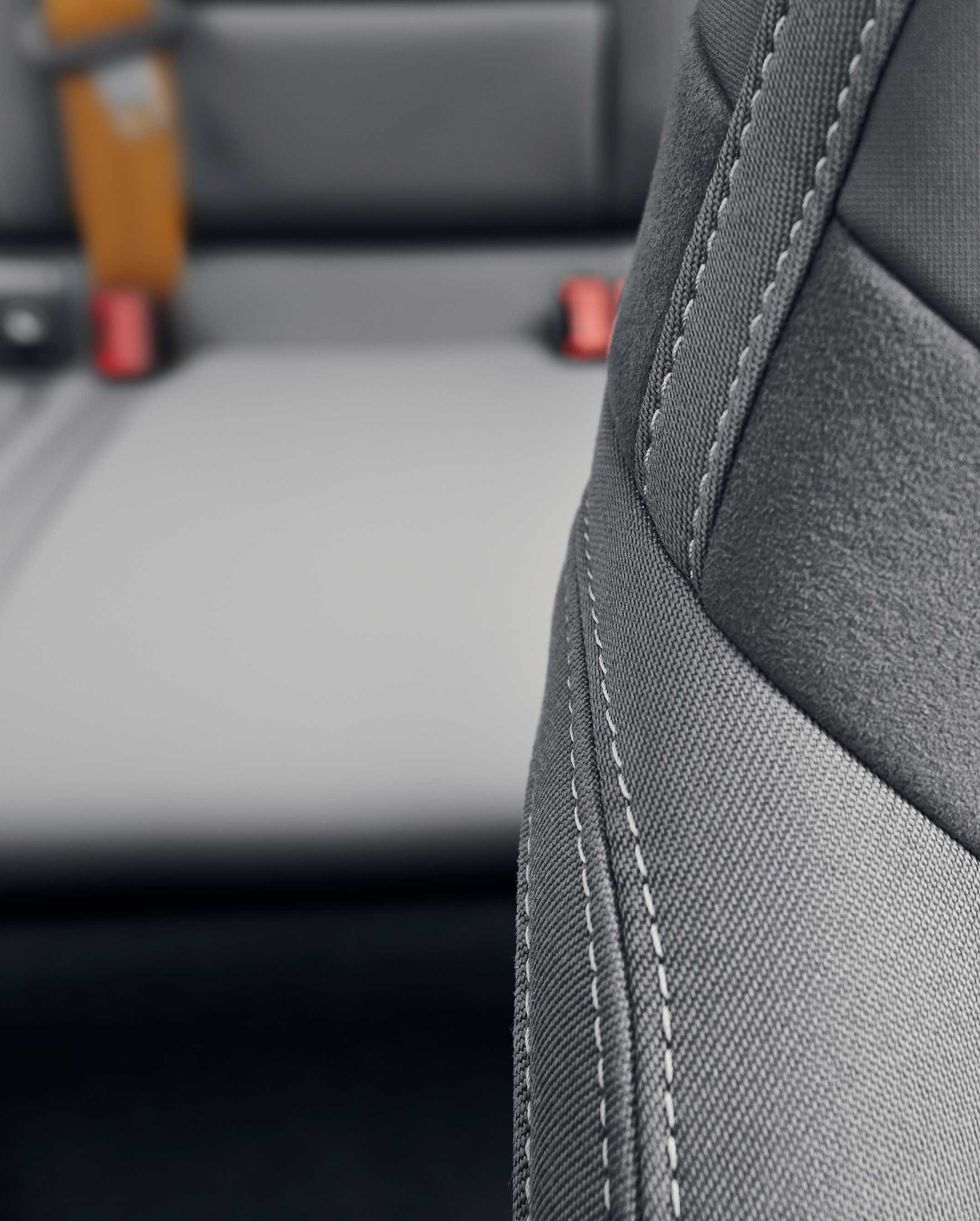The Takeaway: Polestar is a new car company with the resources of a big automotive corporation—Volvo and its parent company, Geely. Its first all-electric sedan is a polished, high-tech, legitimate alternative to the Tesla Model 3, but with slightly less range.
- Safety tech includes the first inner front seat airbags, set near the center console.
- The Android Automotive OS system lets you adjust the temperature with your voice.
- The first examples will be delivered in Fall 2020.
SPECS
Base Price: $59,900 (not including $7,500 EV rebate)
Range: 291 miles (Polestar estimates “mid-200s” for typical use )
Power: 408 hp, 487 lb.-ft.
Zero to 60: 4.45 sec.
Battery capacity: 78 kWh
Charge time (11kW home box, zero to 100%): 8 hours
Charge time (public 150kW DC fast charger, zero to 80%): 40 minutes
The biggest names —Audi, Chevrolet, Jaguar, Mercedes-Benz, Porsche—are now selling electric cars. So far, none of them quite match the combination of range, speed, convenience, and intangible specialness of a Tesla. But the new Polestar 2 comes close, as special as the Tesla Model 3. Just for different reasons.
What is Polestar?
Geely is a conglomerate based in Zhejiang, China. It produces its own cars and owns Volvo, which it acquired in 2010. Under Geely, Volvo had used the name Polestar (a variation on a Swedish word for “guiding light”) to designate performance Volvos, similar to BMW’s M cars or Mercedes-AMG. Then in 2017, Volvo and Geely announced that Polestar would become a standalone company. Its vehicles, the plug-in hybrid Polestar 1 and now the Polestar 2, have parts that you’ll recognize from modern Volvos. But they have non-Volvo Vehicle Identification Numbers. Polestar employees call Volvo its “sister company.”
Polestar is technically a new company, but unlike Tesla, it’s connected to a large corporation, which means, for example, access to Volvo’s driver-assistance tech,. I mention this corporate backstory because it manifests in the Polestar 2. The car is a blend of radical futurism and established conventions. And for the way we drive in 2020, the formula works. Some might still prefer a Tesla Model 3, of course. But at the very least, the Polestar 2 is an affirmation that having more great electric cars to choose from is good for customers, and the entire automotive industry.
Range, Speed, and Charging
Ever since I first drove a Model 3, I’ve wanted it for my next car, whenever my 2004 Volvo XC70 dies. I'm not special for coveting one. Of the percentage of cars sold in the U.S. that are all electric, Tesla owns that market. Driving one, for me, explains why. The cars popularized futuristic conveniences (smartphone-as-key, no-lag touchscreens). They accelerate like hell (a $133,000 Model S P100D will dust anything except a few million-dollar hypercars). And they and run on a huge, growing charging network. Ignore CEO Elon Musk’s scandals and Tesla-loyalists’ Tweets. Tesla made electric cars practical, and fun.
Part of that success came from building EVs with enough range to feel as useful as gas engine-equipped competitors. It doesn’t really matter that the average American only drives 29 miles a day, which even the shortest-range electric cars have been able to handle for years. A fully-charged EV needs to at least come close to the freedom you get a full tank of gas. For the last several years, 200 miles per charge has been the unofficial minimum—the sub-$40,000 Tesla Model 3 and Chevrolet Bolt both hit 250 miles. The Polestar 2 clears that bar at around 250 miles, but sits below the Long Range Plus Tesla Model S’s 402 miles.
As for speed, the Polestar 2 will go zero-to-60 in 4.45 seconds. The $54,990 Model 3 Performance’s 3.2 seconds feels slightly more urgent, but anything under 5 seconds means thrilling highway merges. Also like the Model 3, the Polestar 2 has unusually good steering feel, and the right amount of suspension feedback. During my test drive, it stayed planted through aggressive cornering, but then become pleasantly calm during tedious highway commutes. The Polestar 2 clears the 2020 baselines for speed and range in an electric car, and is also a pleasure to drive in every practical scenario.
You do, however, notice the difference between a Tesla and the Polestar—or any non-Tesla EV—when it’s time to recharge. During my time with the Polestar 2, I used the car's Google Maps system to find a ChargePoint station. I installed the ChargePoint app on my iPhone, created an account, entered my credit card numbers. The charger unlocked and started powering up the car at a rate of roughly 25 miles of per hour — which is slower than a 150-kW V2 Tesla Supercharger, which will replenish over 100 miles per hour, or a claimed, 1,000 miles per hour for V3 Superchargers. If I had gone to an Electrify America charger instead, I wouldn’t need to create an account as long as I had a credit card to swipe.
Is switching charger providers tolerable? Of course. It's only slightly more complicated than refueling at a Shell versus an Exxon. And for EV owners with any routine to their driving, this is a minor issue, especially if you have a garage outfitted with a wall charger that will charge to full overnight. But compared to Tesla’s system of one-app, one-account, and automatic payment, navigating providers can look like juggling TV streaming services. It’s no fault of Polestar’s, and hopefully both charging speeds and ease-of-use will improve as infrastructure expands. But it's a reality of electric vehicle ownership that will, on occasion, require patience.
Autonomous Systems
Of the new vehicles with autonomous capabilities that I’ve tested, Tesla’s Autopilot and Cadillac’s Super Cruise are the most advanced. But in practice, neither is close to sci-fi fantasy. In both, you still need to look at the road. And in the Tesla, at least one hand needs to stay on the steering wheel, ready to intervene. No peeking down to text or scroll.
That makes the Polestar’s comparatively restrained driver assistance tech completely appropriate for 2020. It has adaptive cruise control, which actually makes highway driving less tiring, and comforting automatic braking. The 2 also has expected, but very useful, collision-avoidance tools, such as a top-down camera view that’s handy for parallel parking.
Which is to say, the Polestar 2 loses nothing by not having as many self-driving tricks or promises as other cars. Level Four autonomy (no human intervention) is far away. Polestar, like any car company, is better off for using resources for parts of the driving experience where it really counts.
The Interior
Polestar’s cabin starts with the brilliant simplicity of Tesla’s one-big-tablet setup in the Model 3 and Y, and adds what, after several hours of driving, feels like the right amount of familiarity. The 2 has a dashboard, which can be set to show several arrangements of vital information—speed, range, navigation. The center screen can show just Google Maps, Spotify, etc., or break into quadrants. Controls for functions like climate, seat heaters, and cameras, are usually always visible in an upper or lower dock.
The gear selector knob, volume dial, play/pause, and defrosters are all dedicated hard buttons. The steering wheel buttons skip tracks and change the volume, and toggle the radar cruise control. Same as newer Teslas, the Polestar 2 unlocks by reading your paired smartphone from your pocket or bag. You sit down, and shift into drive or reverse, and press the P to park when you’re done. Intuitive and fast.
Underneath those apps, though, is a system that’s closer to a wheeled smartphone than any other car. The 2 runs on Android Automotive OS, which works like an Android phone. Give the Spotify app your credentials, and your playlists are all there. Sign in to Google Maps, and you’ll see shortcuts for your saved locations.
Also like an Android phone, you can control most of it with your voice, through Google Assistant. In my experience testing phones and home speakers against Siri and Alexa, Assistant is often the most accurate and better than the voice systems you get in a Mercedes-Benz or Audi. But, same as any voice assistant, I had to remember to be specific. For example, “Play the latest episode of the Accidental Tech Podcast,” opened up Google Podcasts. But since I don’t use Google Podcasts, I wouldn’t be able to, say, exit the car, and continue listening from the same place on my iPhone. Instead, I had to say, “Play the latest episode of the Accidental Tech Podcast on Spotify.” This gets easier with practice, but there are times when it’s tempting to ignore safety and just tap the screen a few times. Same goes for saying, “Set the interior temperature to 72 degrees”—novel, and probably safer, but not obviously faster than turning a knob. And that’s assuming the car has enough signal strength to handle your voice processing.
Credit, though, to Polestar engineers for realizing that they were better off just using existing Google technology, rather than trying to build one in-house. Saying, “Ok, Google, take me to Easton, Pennsylvania,” and having it actually work every time felt like a breakthrough. Of course, there are other way to achieve the same effect. You can use the Google Maps phone app’s dictation option, or talk to Siri via Apple CarPlay or Android Auto (both of which you can also use in the Polestar). And I remember my friend’s Acura TSX from 2004, which could find you a Thai restaurant via voice. But it’s different in the Polestar 2. Voice commands are always on, no button-pressing necessary. And since it uses the map and music apps I prefer, both remember my locations and playlists. It works.
Tech aside, the Polestar 2 is airy and comfortable. I’m five foot eleven, and with the driver’s seat in my driving position, I had more room in the back seat than most other sedans. The glass roof only slightly raises the ceiling height, but make the space feel much larger. Leather is an option, but the 2’s standard interior is vegan fabric that’s comfortable and wipes down easily. Plus it kept cool, even in summer heat. The Volvo-grade luxury feels appropriate for a $60,000 car.
Quality Control
In the years I’ve covered Tesla, I’ve seen minor news morph into sensationalism simply because Tesla stories get clicks—for example, how every Tesla fire becomes a headline, while gasoline cars are more likely to catch fire. But even if the reports about leaks, body panel issues, and long wait times for repairs are only from a small, vocal group, it’s in addressing those issues where Polestar could have value. Being part of a massive parent company means access to people and resources with decades of experience meeting production and customer service standards. Ideally, that translates to a pleasantly uneventful ownership experience for most Polestar owners.
And maybe that’s the idea. Unlike a Tesla, a Polestar will probably never have fart mode, or arcade games. But it does have the responsiveness, speed, range, and technology that make the Model 3 so desirable. The Polestar 2 might be the electric car for people who don’t want to make a thing of it. Either way, count me as the first to celebrate the fact that we now have enough electric cars to choose from that personal expression is even a factor. As soon as my station wagon dies, I’ll have a decision to make.
As Editor in Chief, Alexander oversees all of Popular Mechanics’ editorial coverage across digital, print, and video. He has been a science and technology journalist for over 10 years and holds a Master of Arts degree from the Columbia University Graduate School of Journalism. He was previously Technology Editor for Popular Mechanics and before that, a contributor to publications including the Wall Street Journal, Wired, Outside, and was a product tester and reviewer for The Wirecutter. He has been called on to appear on live and taped broadcast programs including Today and programs on MSNBC. He lives in Pennsylvania and rides a 2012 Triumph Street Triple R motorcycle.
